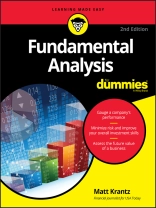Determine the strength of any business with fundamental analysis
Have you ever wondered the key to multibillionaire Warren Buffet’s five-decade run as the most successful investor in history? The answer is simple: fundamental analysis. In this easy-to-understand, practical, and savvy guide, you’ll discover how it helps you assess a business’ overall financial performance by using historical and present data to forecast its future monetary value—and why this powerful tool is particularly important to investors in times of economic downturn.
It’s more important than ever for investors to know the true financial stability of a business, and this new edition of Fundamental Analysis For Dummies shows you how. Whether you’re a seasoned investor or just want to learn how to make more intelligent and prudent investment decisions, this plain-English guide gives you practical tips, tricks, and trade secrets for using fundamental analysis to manage your portfolio and enhance your understanding of shrewdly selecting stocks!
* Predict the future value of a business based on its current and historical financial data
* Gauge a company’s performance against its competitors
* Determine if a company’s credit standing is in jeopardy
* Apply fundamental analysis to other investment vehicles, like currency, bonds, and commodities
With the help of Fundamental Analysis For Dummies, you just may find the bargains that could make you the next Warren Buffet!
Содержание
Introduction 1
Part 1: What Fundamental Analysis Is and Why You Should Use It 5
CHAPTER 1: Understanding Fundamental Analysis 7
CHAPTER 2: Getting Up to Speed with Fundamental Analysis 19
CHAPTER 3: Gaining an Upper Hand on Wall Street: Why Fundamental Analysis Gives Investors an Edge 37
CHAPTER 4: Getting Your Hands on Fundamental Data 55
Part 2: How to Perform Fundamental Analysis 75
CHAPTER 5: Analyzing a Company’s Profitability Using the Income Statement 77
CHAPTER 6: Measuring a Company’s Staying Power with the Balance Sheet 97
CHAPTER 7: Tracking Cash with the Statement of Cash Flow 115
CHAPTER 8: Using Financial Ratios to Pinpoint Investments 133
CHAPTER 9: Mining the Proxy Statement for Investment Clues 153
Part 3: Making Money with Fundamental Analysis 171
CHAPTER 10: Looking for Fundamental Reasons to Buy or Sell 173
CHAPTER 11: Finding a Right Price for a Stock Using Discounted Cash Flow 195
CHAPTER 12: Using the Annual Report (10-K) to See What a Company Is Worth 213
CHAPTER 13: Analyzing a Company’s Public Comments and Statements 233
CHAPTER 14: Gleaning from the Fundamental Analysis Done by Others 245
CHAPTER 15: Performing ‘Top Down’ Fundamental Analysis 265
Part 4: Getting Advanced with Fundamental Analysis 277
CHAPTER 16: Digging into an Industry’s Fundamentals 279
CHAPTER 17: Pinpointing Trends Using Fundamental Analysis 295
CHAPTER 18: Avoiding Investment Blow-Ups with Fundamental Analysis 311
CHAPTER 19: Marrying Fundamental Analysis with Technical Analysis 325
Part 5: The Part of Tens 345
CHAPTER 20: Ten Things to Look at When Analyzing a Company 347
CHAPTER 21: Ten Things Fundamental Analysis Cannot Do 355
Index 365
Об авторе
Matt Krantz, a nationally known financial journalist, has been writing for USA Today since 1999. He covers financial markets and Wall Street, concentrating on developments affecting individual investors and their portfolios. Matt also writes a daily online investing column called ‘Ask Matt, ‘ which appears every trading day at USATODAY.com.












